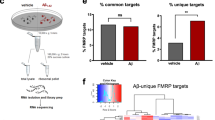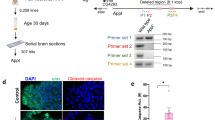Abstract
Replying to T. Jaworski et al. Nature 480, doi:10.1038/nature10615 (2011)
GSK-3 has been implicated in the pathogenesis of Alzheimer’s disease through regulation of tau phosphorylation, cellular responses to amyloid-β and processing of amyloid precursor protein (APP) to amyloid-β. We previously reported1 that inhibition of GSK-3 reduces the accumulation of Aβ40 and Aβ42 (amyloid-ß peptides of 40 and 42 amino acids) in mouse brain and cell culture and that knockdown of Gsk3a reduces amyloid-β accumulation in CHO cells, indicating that Gsk3a contributes to the processing of APP in this context1. At about the same time, others reported that knockdown of Gsk3b reduces amyloid-β production and overexpression of active Gsk3b enhances amyloid-β production2,3,4. A reasonable explanation for these findings, as suggested previously2,5,6, was that both of these highly similar enzymes contribute to APP processing and their respective contributions depend on cell type, relative abundance and assay conditions. Jaworski et al.7 now show that APP can be processed in mouse brain in the absence of either Gsk3a or neuronal Gsk3b.
Similar content being viewed by others
Main
However, Gsk3a and Gsk3b are highly homologous and frequently redundant genes8,9. For this reason, it is not possible to exclude a role for GSK-3 with single gene knockouts. Furthermore, structurally and mechanistically diverse GSK-3 inhibitors reduce amyloid-β accumulation in vivo and in cell culture, including lithium, kenpaullone, bisindolylmaleimide I, FRAT peptide, the TDZD-related NP12 and kinase-dead GSK-3 (refs 1–6, 10, 11). These compounds inhibit both GSK-3α and GSK-3β and therefore get around the issue of redundancy. Although off-target effects for these diverse GSK-3 inhibitors could, formally, explain their effects on APP processing, a far more plausible explanation is that these compounds act through GSK-3 inhibition.
Jaworski et al.7 show that APP can be processed in mouse brain in the absence of either Gsk3a or neuronal Gsk3b, but do not examine redundant functions of Gsk3a and Gsk3b in APP processing and do not consider the substantial body of work showing that acute inhibition of GSK-3 reduces amyloid-β accumulation in vivo. The simplest explanation for these findings2,5,6 is that both Gsk3a and Gsk3b can contribute to APP processing and that inhibition of GSK-3 reduces amyloid-β in Alzheimer’s disease models.
References
Phiel, C. J., Wilson, C. A., Lee, V. M. & Klein, P. S. GSK-3α regulates production of Alzheimer's disease amyloid-β peptides. Nature 423, 435–439 (2003)
Ryder, J. et al. Divergent roles of GSK3 and CDK5 in APP processing. Biochem. Biophys. Res. Commun. 312, 922–929 (2003)
Li, B. et al. FRAT1 peptide decreases Aβ production in swAPP751 cells. FEBS Lett. 553, 347–350 (2003)
Su, Y. et al. Lithium, a common drug for bipolar disorder treatment, regulates amyloid-β precursor protein processing. Biochemistry 43, 6899–6908 (2004)
Huang, H. C. & Klein, P. S. Multiple roles for glycogen synthase kinase-3 as a drug target in Alzheimer’s disease. Curr. Drug Targets 7, 1389–1397 (2006)
Huang, H. C., O’Brien, W. T. & Klein, P. S. Targeting glycogen synthase kinase-3 in Alzheimer’s disease. Drug Discov. Today Ther. Strateg. 3, 613–619 (2006)
Jaworski, T. et al. GSK-3α/β kinases and amyloid production in vivo. Nature 480 10.1038/nature10615 (2011)
Doble, B. W. & Woodgett, J. R. GSK-3: tricks of the trade for a multi-tasking kinase. J. Cell Sci. 116, 1175–1186 (2003)
Doble, B. W., Patel, S., Wood, G. A., Kockeritz, L. K. & Woodgett, J. R. Functional redundancy of GSK-3α and GSK-3β in Wnt/β-catenin signaling shown by using an allelic series of embryonic stem cell lines. Dev. Cell 12, 957–971 (2007)
Sun, X. et al. Lithium inhibits amyloid secretion in COS7 cells transfected with amyloid precursor protein C100. Neurosci. Lett. 321, 61–64 (2002)
Serenó, L. et al. A novel GSK-3β inhibitor reduces Alzheimer’s pathology and rescues neuronal loss in vivo. Neurobiol. Dis. 35, 359–367 (2009)
Author information
Authors and Affiliations
Rights and permissions
About this article
Cite this article
Phiel, C., Wilson, C., Lee, VY. et al. Phiel et al. reply. Nature 480, E6 (2011). https://doi.org/10.1038/nature10616
Published:
Issue Date:
DOI: https://doi.org/10.1038/nature10616
Comments
By submitting a comment you agree to abide by our Terms and Community Guidelines. If you find something abusive or that does not comply with our terms or guidelines please flag it as inappropriate.



